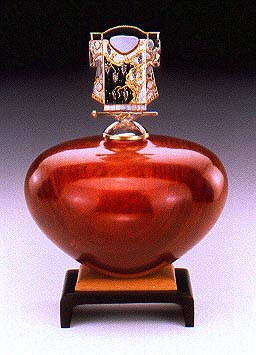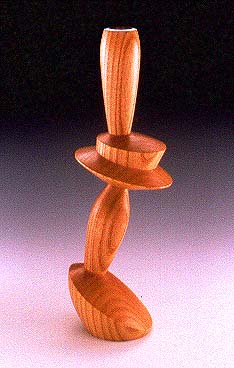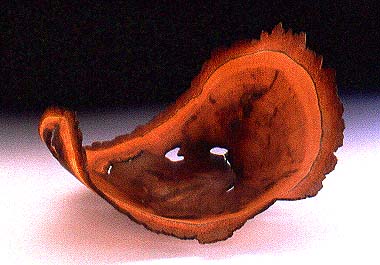

May Issue 2000
Major Exhibit on Woodturning at Mint Museum of Craft + Design, Charlotte, NC
My woodworking is a labor of love. It gives
me a feeling of being in a church, or in God's presence, when
taking a piece of wood and making something out of it. I feel
a deep appreciation to be able to discover the beauty God has
given us in our trees.
- Rude Osolnik
 William & Marianne Hunter
William & Marianne Hunter
Turning Wood into Art: The Jane and Arthur Mason Collection on display at Charlotte, NC's Mint Museum of Craft + Design from May 20 through Oct. 8, showcases 125 objects, from bowls and vessels to abstract sculptural works, from one of the world's foremost collections of contemporary lathe-turned wood. Included are works of unsurpassed richness and variety from 43 North American and European masters of the craft, among them David Ellsworth, Mark and Mel Lindquist, Ed and Philip Moulthrop, Ron Kent, Virginia Dotson, Rude Osolnik, Bob Stocksdale and Todd Hoyer.
Woodturning is perhaps the only field where artists sign the name of the material on the finished work alongside their own name. By co-signing the wood on their objects, wood turners testify to the importance of nature's role in their art and acknowledge the collaborative interaction between wood and worker in the creative process.
Turned-wood objects embody a provocative combination of the natural and the manmade. The dialogue between an artist and the wood on the lathe is a balancing act between precise control and the forms of chance, a collaboration of hand, machine, mind and matter. The allure of a turned-wood piece resonates from the interaction of the material's inherent beauty and the turner's mastery of technique, concept and form.
The field of woodturning has matured rapidly over the past two decades, achieving an exciting level of quality, artistic expression and technical innovation.
The objects on display range from James Prestini's Mexican Mahogany Bowl epitomizing the classic ideals of extreme simplicity, beautifully grained patterns, thin and taut walls, and perfect proportion so valued by first-generation turners, to the spontaneous sequences of pattern, shape, texture and surface treatment, created by chainsaw, in Mark Lindquist's sculpture Amalgam II. Accompanying the exhibition is a major publication by Harry N. Abrams Press of New York with feature essays by Suzanne Ramljak, Curator of Exhibitions at the American Federation of Arts, and Michael Monroe, formerly executive director of the American Crafts Council.
The popularity of woodturning has undergone sharp ascents and declines throughout history, according to Ramljak. During the 16th and 17th centuries, lathe-turning was almost an obligatory activity within European courts. Keiser Rudolph II (1552-1612) and Czar Peter the Great (1672-1725) practiced turning wood as a form of recreation and from the prevailing belief that God was a turner as the earth and planets were perfect spheres whose concentric forms could only have been crafted on a lathe. At its artistic low ebb, woodturning was regarded as the domain of the hobbyist in the garage. The recent surge in popularity has wood-turned objects poised to regain a key role within contemporary society as evidenced by their widespread inclusion in museum exhibitions and collections in the 1990s.
 Mark Sfirri
Mark Sfirri
Arthur and Jane Mason of Washington, D.C. have collected over 600 woodturned objects since being inspired by a 1986 exhibition of turned wood bowls from the Edward Jacobson Collection (now housed at Arizona State University) at the Smithsonian Institution's Renwick Gallery of American Craft. The Masons have contributed pieces to the Renwick Gallery, the Detroit Institute of Art, the American Craft Museum and the Art Institute of Chicago, among other institutions. They were persuaded by wood turner Mark Lindquist, after his initial visit, to keep their vision together, donate to one museum, and publish the history of the collection.
"When Mark Leach called us in 1996 to tell us that NationsBank (now Bank of America) was supporting a new Mint Museum of Craft + Design in downtown Charlotte, and that he would become director, we knew that our collection should go to North Carolina," said Jane Mason.
Leach and the Masons selected 126 works representative of the breadth of the collection to be donated to the new museum.
"At the core of our vision is the reawakening, the Renaissance of woodturning as an art," stated Arthur Mason. "Our collection grew from the burst of creativity when the early artists - James Prestini, Bob Stocksdale, Rude Osolnik, Ed Moulthrop, Mel Lindquist and Dale Nish, each alone in his studio developing his style, first met and inspired each other in the 1960s. It includes the next major group of turners to emerge -David Ellsworth, Mark Lindquist, Hap Sakwa and others from the Jacobson Collection."
Essayist Suzanne Ramljak writes that the exceptional quality and scope of the Arthur and Jane Mason Collection allows for a sustained analysis of a full range of traits, virtues and issues that define the turned-wood object. Part of woodturning's dubious reputation among the craft world's long-standing worship of the handmade is the peculiar blend of the organic and the industrial. When wood is mounted on a lathe, nature becomes subject to the forces of industry. The hybrid result lends turned-wood objects much of their interest and even poignancy.
 Todd Hover
Todd Hover
Interestingly, avoiding perfection may be the biggest challenge that turners face since the lathe allows for the creation of precisely symmetrical and finished forms. While imperfection in an object imparts a sense of life, mathematical precision often produces sterility.
Some turners chose to efface all traces of the natural material through lacquer, paint or elaborate carving, while others limit their manipulation of the material, allowing the wood to remain as raw as possible. The majority of turners are drawn to the medium precisely because wood is such an irregular material and lends an exciting unpredictability to the creative process.
"The shape of a log, the grain pattern, cracks, faults or rotten spots all play a part in my discovery of new shapes," remarked Bob Stocksdale.
While turned-wood objects are linked to the primal natural world, they also participate in the more progressive features of avant-garde culture, namely chance methods and found objects. The creative process involves as much finding and selecting as it does making and constructing. While turners manipulate the wood forms that they find pre-existing in nature, or make slight modifications as in Melvin Lindquist's Top Bowl (1985) or Mark Lindquist's Chieftain's Bowl (1988), they do not construct or sculpt their works in the traditional sense.
"Unlike clay, glass, metals and fiber, where the material is shifted and rearranged to the artist's desire, my works "have always been there"," remarked Ed Moulthrop. "The wood you see is the wood exactly as it was created. I simply uncover it and there it is!"
Michael Peterson adds, "While harvesting and collecting burled wood, I discover and explore the physical material - a process that yields all the excitement and energy found in a treasure hunt or like that in unearthing artifacts from an ancient culture."
Another essential aspect of woodturning is the use of chance or uncontrolled effects in the creative process. Free-style turning, an approach pioneered by artists like David Ellsworth, incorporates defects in the wood such as splits, rotten areas and bark inclusions to produce uniquely irregular forms. In the chance-filled technique of green turning, uncured wood is turned on the lathe and allowed to dry after turning. As the piece slowly cures the wood begins to shrink and assume surprising shapes beyond the pale of the turner.
"The procedure produces an asymmetrical form that allows the life force of the tree to have the final word, thus freeing me from total control over the final form," stated Todd Hoyer.
Essayist Michael Monroe notes that a wood turner has little assurance of predictability, purity and uniformity from the material. Having been predetermined by natural process beyond his or her control - soil condition, drought, disease, lightening and fire - the turner's dialogue is dually complex. Act and react. As turner Virginia Dotson expresses the process, "We dream of perfect harmonies.. .chance intervenes."
Today's turners are more likely to consider using the lathe as only the first step of several toward a desired end. Some contemporary turners juxtapose wood with other materials, such as gold, sterling silver, baroque pearls, cloisonné enamel and semiprecious stones (even barbed wire!). Other innovations include the application of industrial chemicals such as plastic resins and epoxies; the use of industrial power tools such as chain saws, sandblasters and flexible drill shafts; the technique of segmenting and laminating woods to achieve precision surface decorations; and the introduction of multi-axis turning techniques.
On the issue of the non-utilitarian nature of most turned-wood vessels, Mark Lindquist's remarks on a spalted bowl sufficiently summarizes the thoughts of most wood turners. "Its function is to display the beauty of nature and to reflect the harmony of man. It is wrong to ask the spalted bowl to function as a workhorse as well, to hold potato chips, or salad or to store trivialities. The bowl is already full. It contains itself and the space between the walls."
Like other abstract art, turned-wood forms primarily serve as objects for meditation or arousal, and their foremost impact is on the sensual level.
"Electronic or digital media - television,
video, computers, virtual reality - bring with them dematerialized
and disembodied relations, replacing direct physical contact with
mediated virtual contact," wrote Ramljak. "The sense
of wholeness that organic forms impart thus becomes more necessary
today as a source of physical and psychic sustenance."
For further information check our NC Institutional Gallery listings
or call the museum at 704/337-2000 or visit the Mint web site
at: (http://www.mintmuseum.org).
Mailing Address: Carolina Arts, P.O. Drawer
427, Bonneau, SC 29431
Telephone, Answering Machine and FAX: 843/825-3408
E-Mail: carolinart@aol.com
Subscriptions are available for $18 a year.
Carolina Arts
is published monthly by Shoestring
Publishing Company, a subsidiary of PSMG, Inc.
Copyright© 2000 by PSMG, Inc., which published Charleston
Arts from July 1987 - Dec. 1994 and South Carolina Arts
from Jan. 1995 - Dec. 1996. It also publishes Carolina Arts
Online, Copyright© 2000 by PSMG, Inc. All rights reserved
by PSMG, Inc. or by the authors of articles. Reproduction or use
without written permission is strictly prohibited. Carolina
Arts is available throughout North & South Carolina.